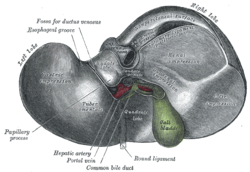Porta hepatis
| Transverse fissure of liver | |
|---|---|

Inferior surface of the liver.
|
|

The portal vein and its tributaries. (Porta hepatis labeled at upper left.)
|
|
| Details | |
| Identifiers | |
| Latin | porta hepatis |
| Dorlands /Elsevier |
p_29/12660169 |
| TA | A05.8.01.016 |
| FMA | 15758 |
|
Anatomical terminology
[]
|
|
The porta hepatis or transverse fissure of the liver is a short but deep fissure, about 5 cm long, extending transversely beneath the left portion of the right lobe of the liver, nearer its posterior surface than its anterior border.
It joins nearly at right angles with the left sagittal fossa, and separates the quadrate lobe in front from the caudate lobe and process behind.
It transmits the following:(vein most posterior, duct most anterior)(Anterior to posterior Duct, Artery, Vein respectively)
The hepatic duct lies in front and to the right, the hepatic artery to the left, and the portal vein behind and between the duct and artery.
It also transmits nerves and lymphatics.
When the patient is supine, and the liver observed inferiorly (as in a surgeon's perspective), the important structures demarcating its inferior aspect can be represented by a hepatic "H" figure. The left vertical limb of the "H" defines the left and right functional lobes, while the right vertical limb of the "H" defines the right and left anatomical lobes. The horizontal line between the vertical limbs of the "H" represents the porta hepatis. The quadrate and caudate lobe lie superior and inferior to this line respectively.
This article incorporates text in the public domain from the 20th edition of Gray's Anatomy (1918)
...
Wikipedia
